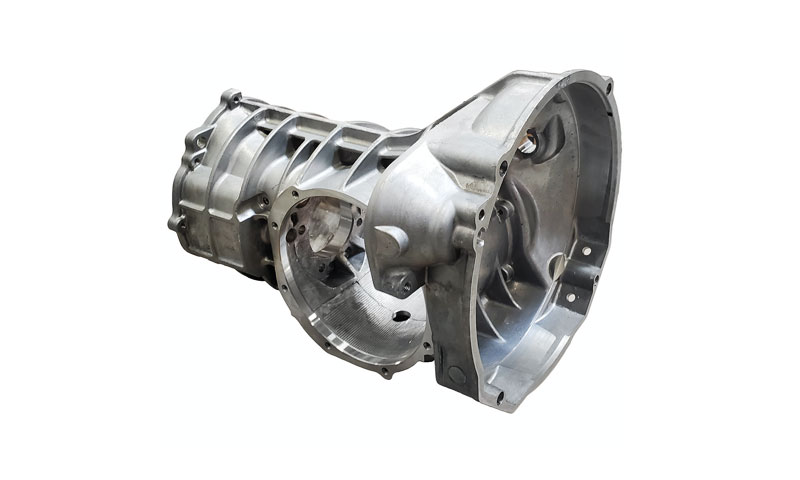1. 执行摘要
铝 压铸 (principally high-pressure die casting, HPDC) is a mature, high-throughput manufacturing route that delivers near-net-shape, 尺寸准确, lightweight parts with good surface finish for the automotive industry.
It is widely used for housings (transmission, 变速箱, motor), 结构支架, housings for power electronics and pumps, and many accessory parts.
The main engineering tradeoffs are: per-part cost vs. 体积, porosity control vs. productivity, 和 mechanical performance vs. process/post-process route.
Modern options (真空高压直流, squeeze, semi-solid, HIP and T6 heat treatments) let engineers match cast part integrity to demanding automotive requirements including safety-critical and fatigue-sensitive applications.
2. Market & engineering drivers for aluminum die-cast parts in automotive
- Lightweighting: switching from steel to aluminum can reduce part mass by ~40–50% for the same volume (Al density ≈ 2.68–2.71 g·cm⁻³ vs steel ≈ 7.85 g·cm⁻³).
Weight reductions directly improve fuel economy/EV range. - 一体化 & parts consolidation: die casting enables complex geometries, 集成的肋骨, bossing and channels that reduce part count and assembly cost.
- Cost at volume: HPDC has low per-part cost at medium-to-high volumes (thousands to millions).
- 热的 & EMI needs: die-cast housings for e-motors and power electronics also act as heat sinks and electromagnetic shields.
- Shift to EVs: EV motors and inverters create new high-volume opportunities for precision aluminum cast housings.
- 耐用性 & 腐蚀: appropriate alloys and coatings deliver automotive service life across climates.
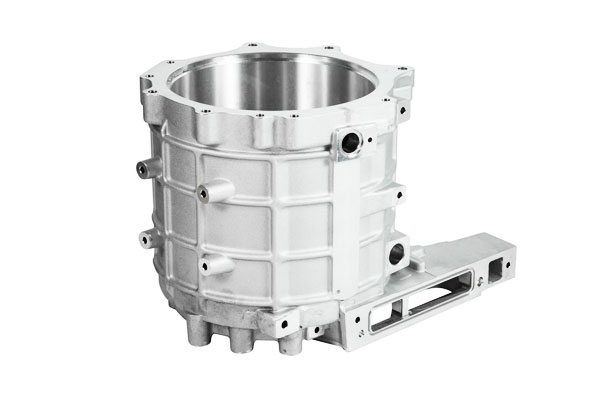
3. Typical aluminum die-casting processes
A key choice is process family — each has different capability/cost:
- 高压铸造 (HPDC, 冷室): the industry workhorse for Al automotive parts. 快速周期时间, 薄壁, 出色的可重复性. Best for A380/ADC12 family.
- Vacuum HPDC: adds a vacuum to reduce gas porosity and improve pressure tightness — used for hydraulic housings, oil sumps, safety parts.
- Squeeze / HPDC + Squeeze: applies static pressure during solidification to reduce shrinkage cavities and improve local density; useful for localized critical regions.
- 低压铸造 (LPDC): bottom-fill with low pressure; gentler filling — better for larger/thicker parts but slower.
- Semi-solid / 流变铸造 (thixo): injects semi-solid slurry to reduce turbulence and porosity; higher complexity/cost but improves integrity.
- Post-process routes: 热处理 (T6), 热等静止 (时髦的), machining and surface finishing are common to meet mechanical and fatigue specs.
4. Common Automotive Die-Casting Alloys
| 合金 (通用名称) | 典型化学 (wt%) — Key Elements | 密度 (g·cm⁻³) | Typical As-Cast Mechanical Range (UTS, MPA) | Typical Elongation (铸造, %) | Typical Automotive Uses / 笔记 |
| A380 (Al–Si–Cu family) | Si 8–10; Cu 2–4; Fe ≤1.3; 次要MN, 毫克 | 2.69–2.71 | 200–320兆帕 | 1–6% | General-purpose alloy for housings, 封面, gearbox and transmission cases; excellent fluidity and die life. |
| ADC12 (他是) / A383 | Similar to A380 with regional spec variations | 2.69–2.71 | 200–320兆帕 | 1–6% | Asian industry standard; widely used for electrical housings, 发动机盖, 和结构支架. |
| A356 / A360 (铝-硅-镁族) | Si 7–10; Mg 0.3–0.6; very low Cu/Fe | 2.68–2.70 | 180–300 MPA | 2–8% | Selected for higher ductility, 疲劳性能, 和耐腐蚀性; often used for structural components and motor housings. |
A413 / High-Si variants |
Elevated Si; microstructure optimized for thick sections | 2.68–2.70 | 180–300 MPA | 1–6% | Suitable for thicker-wall castings and components exposed to higher operating temperatures; good stability. |
| 过共晶 / 高硅 (特殊合金) | 和 >12–18% | 2.68–2.72 | 各种; optimized for wear resistance | 低的 | Used for cylinder liner inserts, piston components, or wear-critical surfaces; higher die wear and lower ductility. |
| Proprietary Foundry HPDC Alloys | Tailored chemistries (modified Fe, Sr, 毫克, 晶粒细化剂) | 2.68–2.71 | Foundry-specified | Application-dependent | Customized for improved fluidity, 延性, 机械一致性, die life, or low-porosity casting performance. |
5. Typical Process Parameters & Practical Ranges (Automotive HPDC)
High-pressure die casting for automotive components depends on tight control of melt, die and injection variables.
Below are engineering-level practical ranges and the rationale behind each parameter (use them as starting points for shop trials; final settings must be validated for your alloy, die and geometry).
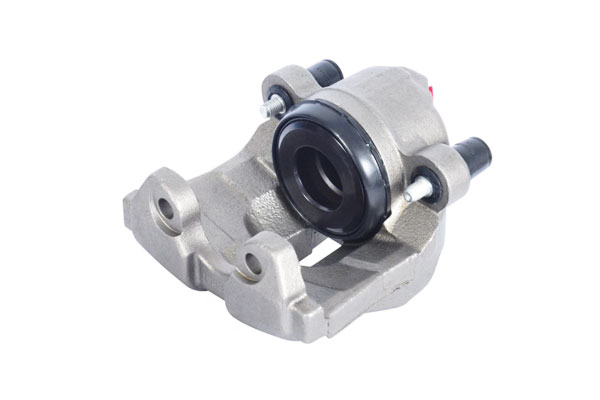
Metal preparation
Melt temperature for common Al–Si alloys typically sits between 660°C and 720°C.
Higher temperatures improve fluidity and help fill thin sections but increase die-soldering and intermetallic growth; lower temperatures reduce shrinkage but risk cold-laps.
Holding furnace setpoints are often 690–720°C to stabilize chemistry and reduce thermal swings.
Dissolved hydrogen must be controlled—target rotary-degassed levels of ≤0.12 mL H₂ /100 g Al (lower for pressure-tight or fatigue-critical parts).
Good skimming and fluxing keep dross low (industry targets commonly <0.3% 按重量).
Die thermal control
Pre-shot die temperatures are generally in the 150–250°C window for automotive castings.
Die temperature uniformity is crucial—seek to keep thermal gradients small (例如, ≤30°C across critical cavities) to avoid localized hot spots, shrinkage or warpage.
Spray and cooling cycle timing (spray on/off and coolant flow rates) are tuned to maintain that balance; spray timing is often in the 1–3.5 s range per cycle depending on part mass.
Injection and shot profile
Modern HPDC uses a two-stage shot profile: a slow initial fill to avoid turbulence followed by a high-velocity second stage to complete filling before freezing begins.
Typical slow-stage speeds are 0.1–0.3 m/s, switching to second-stage velocities from 1.5 到 4.5 多发性硬化症 for most automotive thin-wall parts — very thin sections can see peak speeds up to about 6 多发性硬化症.
The switch-over point is commonly set at 40–70% of cavity fill; optimizing that point minimizes flash and short shots.
集约化 (or holding) pressures to consolidate metal into the mushy zone commonly range 70–160 MPA, with higher values (接近 200 MPA) used for structural, pressure-tight or thin-walled castings.
Vacuum and air-management
Vacuum assistance is widely used for automotive structural castings.
Typical achievable cavity pressures are ≤50 mbar, and critical hydraulic or leak-tight components often use <10 mbar during filling.
Effective vacuum timing requires evacuation immediately prior to fill and maintaining vacuum through initial solidification; fill timing for vacuum HPDC is fast (fractions of a second) so vacuum systems must be capable of rapid cycling.
凝固, clamping and cycle time
Solidification/cooling times vary with casting mass; small thin parts may cool in 3–6 s, while heavier housings need 8–12 s 或更多.
Clamp or locking forces scale with projected area—automotive presses range from several hundred to several thousand tonnes depending on part size.
Typical cycle times for automotive HPDC run ~15–60 s overall (fill, 固化, open, eject), with thin-wall, small parts at the fast end.
6. Design for Die Casting (DFM rules for automotive parts)
Design drives producibility and cost. Key rules:
壁厚
- Target 均匀的壁厚. Typical practical minimum 1–1.5 mm; 1.5–3 mm is common. Avoid sudden changes; 使用逐渐过渡.
肋骨
- Ribs increase stiffness—keep rib thickness ≈ 0.4–0.6 × nominal wall thickness and avoid making ribs thicker than the wall. Use fillets to reduce stress concentrations.
老板
- Keep bosses supported by ribs, avoid heavy bosses causing hot spots; typical boss wall ≈ 1.5–2× nominal wall thickness but with small internal bosses need core support.
草稿 & 弹射
- Provide draft: 0.5°–2° depending on feature depth and texture. More draft for textured surfaces.
鱼片 & 半径
- 避免尖锐的角落; provide fillets (最小 1.0–3.0毫米 depending on scale) to reduce stress concentration and hot tearing.
门控 & 溢出
- Design gates and overflows to promote directional solidification. Place gates to feed thick areas and locate vents to avoid trapped air.
Shrink & 加工津贴
- Linear shrinkage allowances typically 1.2–1.8%; specify machining allowances 0.5–2.0毫米 depending on feature and finish requirement.
宽容 & critical features
- As-cast tolerances commonly ±0.2–1.0 mm; critical bearing bores or sealing faces are usually machined after casting.
7. Typical automotive parts & functional examples
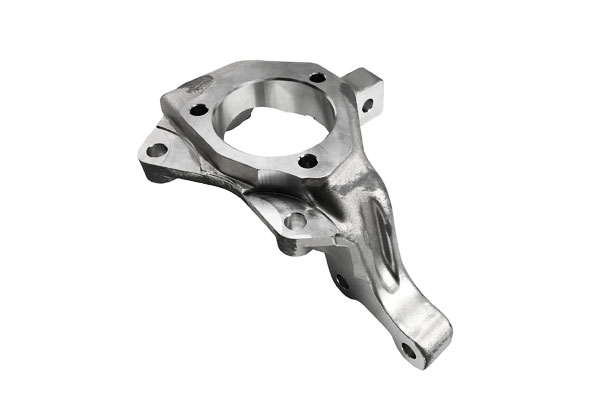
- 传播 / gearbox housings and covers — complex internal bosses, mounting locations; often vacuum HPDC for leak tightness.
- 发动机组件 (封面, oil pumps) — thin walls, 综合老板; require good surface finish.
- E-motor housings / stator housings — act as structural element and heat sink; often A360/A356 variants and T6 after solution treatment to meet mechanical/thermal requirements.
- Suspension brackets, 转向指关节 (在某些节目中) — require high integrity; sometimes cast then heat treated / machined or replaced by forged components depending on fatigue needs.
- Brake caliper housings (certain designs) — require high pressure tightness and fatigue performance; processes may combine HPDC with HIP or squeeze.
- Power electronics housings / inverter casings — require fine features, good thermal conduction and EMI shielding.
Case note: EV motor housings often combine thin fins for cooling, thick bosses for bearings, and require precise roundness on bores — design must account for differential solidification and machining sequences.
8. 微观结构, 机械性能 & 后处理
铝 die-cast parts derive their performance from a tight interplay between (一个) as-cast microstructure produced by rapid filling and die-cooling, (b) the alloy chemistry, (c) process-related defects (primarily porosity), 和 (d) the chosen post-processing route (热处理, 时髦的, 加工, 表面处理).
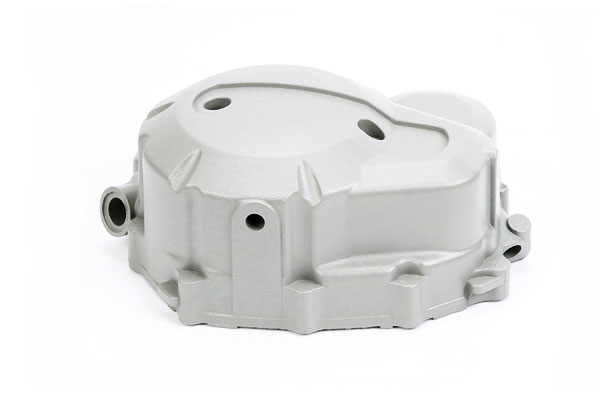
Typical as-cast microstructure — what to expect
- Chilled skin / fine microstructure at the die face. Rapid solidification at the die interface produces a fine, thin “chill” layer (very fine dendrites, refined eutectic) that typically has higher hardness and tends to give good surface strength and wear resistance.
- Intermediate columnar to equiaxed zone. Beneath the chill layer the structure transitions to coarser equiaxed grains and primary aluminum dendrites with interdendritic eutectic (al-是的) and intermetallics.
- Intermetallic phases. Fe-rich (Al–Fe–Si) platelets/needles and Cu- or Mg-containing precipitates form depending on chemistry; these phases are usually brittle and control ductility, fracture initiation and machinability.
- Silicon morphology. In Al–Si alloys, silicon appears as a eutectic phase; 它是 morphology (acicular/platelet vs. modified fibrous) strongly affects ductility.
Sr modification and controlled cooling produce a finer, more rounded silicon which improves toughness and elongation. - Dendrite arm spacing (SDAS). Faster cooling → finer SDAS → higher strength/ductility.
Thin sections solidify faster and therefore typically show better mechanical performance than thick bosses or webs.
Typical mechanical properties
Values below are representative shop-floor engineering targets; actual numbers depend on porosity, SDAS, heat treatment and testing coupon location relative to the casting.
- A380 (typical HPDC alloy)
-
- 铸态UTS: ~200–320 兆帕
- 伸长: ~1–6%
- 布氏硬度 (HB): ~70–95
- A356 / A360 (铝-硅-镁族, often used when higher ductility/ageing is required)
-
- 铸态UTS: 〜180–300 兆帕
- T6 (解决方案 + artificial age) UTS: ~250–360 MPa (common engineering range ~260–320 MPa)
- 产生强度 (T6): ~200–260 MPa
- 伸长 (T6): ~4–10% depending on porosity
- 硬度 (HB, T6): ~85–120
- A413 / high-Si variants — similar UTS bands to A356 as-cast; designed for thicker sections and thermal stability.
Important caveat: 孔隙率 (气体 + 收缩) is a dominant modifier.
例如, even modest increases in average porosity (0.5 → 1.0 vol%) can reduce apparent tensile and, 尤其, fatigue performance substantially — typical fatigue strength reductions of 20–50% are common depending on pore size/position and test conditions.
Post-processing routes and their effects
溶液热处理 & 人工衰老 (T6)
- Who uses it: primarily Al–Si–Mg alloys (A356/A360) to raise strength and ductility.
- Typical cycle (engineering guideline): solutionize ~520–540°C (≈ 6–8 h) depending on casting section size, quench rapidly (水), 然后年龄 155–175°C for 4–8 h (time/temp optimized per alloy).
- 影响: increases UTS and yield, 改善延展性, but accentuates the mechanical consequence of any remaining porosity (IE。, pores become more damaging after T6 because matrix strength is higher).
- Design implication: low porosity must be achieved prior to T6 if fatigue is critical.
热等静止 (时髦的 / 致密化)
- 目的: close internal shrinkage porosity and microcavities to recover near-full density and improve fatigue life and toughness.
- Typical engineering HIP window for Al alloys:~450–540°C 在 ~100–200 兆帕 for 1–4 hours (process and cycle chosen to avoid over-aging or detrimental microstructural coarsening).
- 影响: can increase ductility and fatigue life dramatically; used selectively where cost justified (例如。, safety-critical or aerospace-grade automotive components).
Squeeze / in-die pressure
- 影响: applies static pressure during solidification to reduce shrinkage porosity, improving local density in thick regions without post-cast HIP.
射击 / surface mechanical treatments
- 影响: induces compressive residual stress near surface and improves high-cycle fatigue resistance; commonly used on critical fillets, bolt holes or machined faces.
涂料 & 表面饰面
- 阳极氧化, e-coats, 油漆 protect against corrosion and may mask small surface pores but do not repair structural porosity. Sealing of anodic films improves corrosion resistance in aggressive environments.
Stress relief anneals
- Light stress relief (例如。, low-temp aging or stress relief at ~200–300°C) can reduce residual casting stresses from thermal gradients, improving dimensional stability and reducing SCC risk in susceptible alloys.
9. 常见缺陷, 根本原因 & Remedies
| 缺点 | 外貌 / 影响 | Common root causes | Remedies |
| 气孔隙度 | Spherical pores, lowers strength | 氢气吸收, 湍流填充, poor degassing | 熔体脱气 (旋转), 过滤, 射击轮廓调整, 真空高压直流 |
| 收缩孔隙度 | Irregular cavities in last-solid areas, reduces fatigue | 喂养不良, insufficient intensification/holding | Re-design gates/runners, increase intensification, local chills or squeeze/HIP |
| 冷隔 / 缺乏融合 | Surface line/weakness where flows meet | 低熔体温度, 缓慢填充, poor gate location | Increase melt temp/velocity, redesign gate for flow |
| 热泪盈眶 / 破裂 | 凝固时产生裂纹 | 高克制, localized hot spots | 添加鱼片, modify gating/solidification path, add chills |
| 焊接 (die stick) | 金属粘附到模具上, poor finish | 模具温度, 化学, lubrication failure | Adjust die temp, 涂料, better lubricant |
| 闪光 | Excess metal at parting line | 模具磨损, 错位, excessive pressure | Die maintenance, tighten clamping, optimize pressure |
| 包含 / 矿渣 | Non-metallic chunks inside casting | 熔体污染, filtration failure | 过滤, better melt skimming, furnace maintenance |
| Dimensional drift / 经线 | 超出公差的特征 | Thermal gradients, 未考虑收缩率 | Die compensation, 改善冷却, 模拟 |
10. 经济学 & program considerations
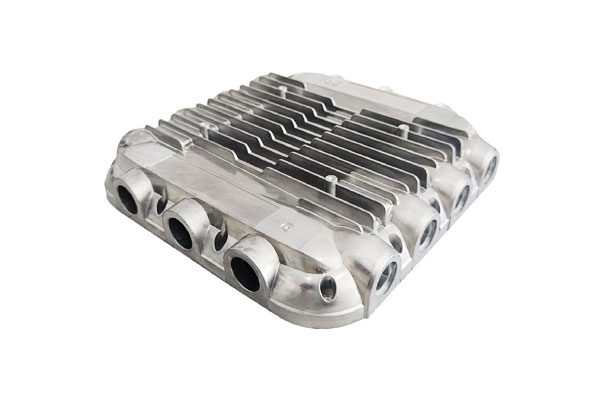
- 工具成本: die cost ranges from tens to hundreds of thousands USD depending on complexity and inserts. Lead time weeks to months.
- 每个零件的成本驱动因素: 合金成本, 周期, 废品率, 加工, finishing and testing.
- Break-even volume: high tooling cost means die casting is economical from thousands to many tens/hundreds of thousands of parts—depends on part mass and machining needs.
- Supply chain considerations: secure raw alloy supply; heat treatment and machining capacity; NDT capability; risks for die revisions. Design for serviceability and manufacturing early.
11. 可持续性 & 回收
- Aluminum recyclability: aluminum scrap is highly recyclable; recycled aluminum (次要) uses roughly ~5% of the energy required for primary smelting (a long-standing engineering estimate).
Using recycled content reduces embodied energy substantially. - 物质效率: near-net-shape casting reduces machining waste vs billet machining.
- Process energy: melting is energy-intensive; efficient melt practice, waste heat recovery and higher recycled content help lower footprint.
- End-of-life: die-cast parts are recyclable; scrap segregation (clean Al vs coated) aids recycling.
- Lightweighting lifecycle benefit: weight savings in vehicles reduce fuel/energy use across life cycle; quantify with LCA for program decisions.
12. Aluminum Die Casting vs. Alternative Automotive Materials
| 材料 / Route | Typical manufacturing routes | 密度 (g·cm⁻³) | 典型的拉伸强度 (MPA) | Typical automotive uses | 关键优势 | Key limitations |
| Aluminum — HPDC (A380 / A356 family) | 高压铸造 (冷室), 真空高压直流, squeeze | 2.68 - 2.71 | As-cast ~180–320; T6 (A356) ~250–360 | Transmission/gear housings, 汽车外壳, 泵主体, 结构支架, inverter housings | 轻的, good castability for complex thin-wall parts, 出色的表面饰面, 良好的导热率, 可回收 | Porosity sensitivity (fatigue/pressure), limited very-high-temp performance, high tooling cost for low volumes |
| Steel — stamped/forged (低的- & 高强度钢) | 冲压, 锻造 + 加工, 铸件 | 〜7.85 | ~300–1000+ (low-carbon → AHSS/forgings) | Chassis members, suspension arms, safety-critical structural parts | 强度很高 & 韧性, established manufacturing chain, cost-effective for many parts | 更重 (mass penalty), corrosion protection often required, multi-process assembly vs integrated cast parts |
| 铸铁 (gray/ductile) | 砂铸, shell mold | ~6.9 – 7.2 | 〜150–350 (gray lower, ductile higher) | 发动机块 (legacy), 制动鼓, 重型外壳 | 出色的耐磨性, 减震, low cost for large parts | 重的, limited thin-wall capability, machining-heavy, poor for lightweighting |
| Magnesium — die casting | HPDC (magnesium dies), squeeze | ~1.74 – 1.85 | ~150–300 | 仪表板, steering wheels, 轻质外壳 | Extremely low density (best weight savings), good stiffness-to-weight, good die-castability | 较低的耐腐蚀性 (requires protection), flammability concerns in melting, higher material cost and lower ductility vs Al in many alloys |
Engineering thermoplastics (例如。, PA66 GF, PPA, 聚苯硫醚) |
注入成型 | ~1.1 – 1.6 (glass-filled higher) | ~60–160 (glass-filled grades) | Interior trims, some housings, non-structural brackets, air ducts | Low cost for high volumes, excellent integration of clips/features, corrosion-free, 重量低 | Temperature limits, lower stiffness/strength than metals, poor high-load fatigue performance, dimensional stability vs metals |
| 复合材料 (CFRP / hybrid) | Layup, resin transfer molding (RTM), automated fiber placement | ~1.4 – 1.7 (system dependent) | ~600–1500 (fiber-direction) | High-end structural panels, crash structures, 车身面板 (low-volume/EV) | Exceptional specific strength & 刚性, excellent lightweighting potential | 高成本, anisotropic properties, challenging reparability and joining, longer cycle times for many processes |
| Aluminum — sand / 永久模具铸件 | 沙子铸造, 永久模具 | ~2.68 – 2.71 | ~150–300 | 大房子, brackets where thin walls not required | Lower tooling cost than die casting for low volumes, good large-part capability | Lower surface finish and accuracy than HPDC, heavier sections, more machining |
13. 结论
Automotive aluminum die casting is a transformative technology that enables the lightweighting, electrification, and sustainability goals of the global automotive industry.
Its unique combination of high-volume efficiency, part integration, and cost competitiveness makes it irreplaceable for powertrain, 结构, and EV-specific components.
As EV adoption accelerates and gigacasting scales, aluminum die casting will remain a cornerstone of automotive innovation—driving lighter, 更有效, and sustainable vehicles for decades to come.
常见问题解答
What alloy is best for an EV motor housing?
Common choices are A356/A360 (铝-硅-镁) when T6 strength and thermal performance are needed; A380 is used for lower-stress housings.
Final choice depends on porosity tolerance, heat treatment capability and machining requirements.
How thin can walls be die cast?
Typical practical minimum is ~1.0–1.5 mm; achievable down to ~1 mm in optimized tooling and process, but expect stricter controls.
Does vacuum HPDC eliminate porosity?
It significantly reduces 气孔隙度 and improves pressure tightness but does not fully eliminate shrinkage porosity; squeeze, HIP or improved gating may be needed for near-full density.
How long does a die last?
Die life varies widely—thousands to several hundred thousand shots—depending on alloy, die steel, 涂料, cooling and maintenance.
Is die casting sustainable?
Yes—especially when high recycled aluminum content is used and near-net shape reduces machining waste.
However melting and die production consume energy; process optimization is essential for best lifecycle performance.
